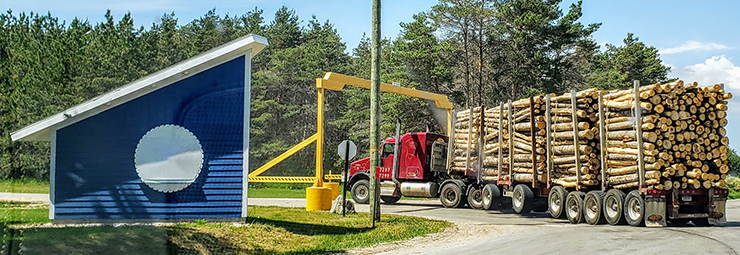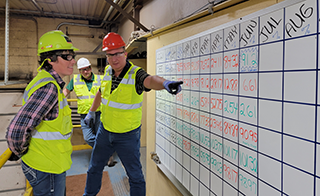Challenges
- Longstanding ways of working
- Frustrating maintenance time overruns
- Lost production time
Solutions
- A concrete plan to engage the whole team
- KPIs that focus and reward team efforts
- Decision-making shifted to the frontlines
- Training in efficient reporting and review conversations
- A new culture of team accountability
Results
- >1 week/year of additional production availability
- 69% reduction in down day overruns
- 10:1 Return on RLG investment
We wanted to improve our planning and execution times for the biggest jobs on down days.
From start to finish, we’ve cut our unscheduled downtime by almost 2 hours per week (20%).
Tom
Plant Manager

Innovating within a long-standing work culture
When Tom became plant manager at this North American Siding Plant, he was determined to make an impact.
Company leadership suggested that he work with RLG to identify opportunities for optimizing the plant’s operations, and Tom was on board.
For 20 years, the plant has provided
consistent value to the company, but we weren’t gaining
ground. I’m about growth and innovation. I wanted to
instill a culture change and start a conversation about how we can use our resources better.
Working with Tom, the RLG team interviewed his Area and Front-Line leadership and looked through their maintenance and production data. Together, they identified areas where better was possible.
However, having operated the same way for decades, it was hard for the manufacturing team to visualize how they could make changes.
They needed a big win to prove to themselves that they could move the needle in a meaningful way.
One high-ROI opportunity that RLG identified was unscheduled downtime for the plant. Tom agreed it was the perfect target to motivate his crews.
I’m a maintenance guy at heart, and I have this mindset that I want our equipment to run the
way it’s intended.
Tom and his team had always been diligent about scheduling preventative maintenance, but they consistently found that down days took longer than planned.
The shutdowns ran over schedule by an average of over 2.5 hours in each 7-day cycle, reducing the overall run time for the plant.
Tom suspected that the overruns might be fixable if the whole team could take ownership of big-picture goals.
Our managers, supervisors, and leaders were all relying on someone else to make decisions. If an
operator needs an answer on something, they shouldn’t have to come to me.
Even the best plants have opportunities to improve. To take this plant from good to outstanding, Tom needed a plan that would:
- Focus the team on a goal they care about.
- Create a more productive planning process for maintenance shutdowns.
- Engage the front lines more deliberately in the plant’s big-picture business goals.
The maintenance and manufacturing offer from RLG felt like the perfect fit.
I learned that the RLG coaches can help you drive culture change through small, minute adjustments, and shift the way
your team views their daily work.
Knowing that streamlining maintenance downtime would result in exciting gains in production volume, Tom engaged RLG.

Driving change with a practical framework
Tom was impressed with the way RLG helped turn his vision into a concrete plan.
They assessed the whole business and assisted in getting a better focus on my goals.”
Using the FAIR model, they showed Tom how he could achieve the attitude shift he wanted with a practical action plan:
- Focus: frame the change around a measurable outcome
- Accountability: track meaningful KPIs that help everyone engage with the goal
- Involvement: invite the right people from each area to regularly contribute ideas, make adjustments, and review results
- Response: challenge low results and celebrate wins to gain momentum
The project centered on a metric that everyone could grasp: time overruns on maintenance down-days.
Winning the team’s support
Knowing that the manufacturing team's way of doing things had been ingrained for decades, RLG had to prove that change was worth the effort.
Many of my managers had over 20 years at this plant, and they didn’t have the desire to learn a new
process. But I needed them to become more engaged with the future planning.
The quickest way to persuade the team was with hard data.
RLG helped different teams analyze historical data and identify KPIs they could track to make maintenance days more efficient and predictable.
Building a structure to look ahead
RLG also trained the leadership on how to perform more effective task planning.
They brought us the idea of critical path planning. Whatever your biggest overall task is, or chain of tasks, that’s your
critical path. For me, it was determining how much time we should plan for maintenance shutdowns.”
For each of the tasks that were performed during the shutdowns, RLG met with the relevant crew to analyze step-by-step what happens during their job.
The process brought visibility so the managers could better plan materials and prerequisite tasks for down days.
We had to make believers out of our team that we could actually cut down on the execution time. We
spent a lot of time in critical path planning.
Now, instead of planning the down day the afternoon before, the team discussed it throughout the previous week and built a repeatable process that everybody understood and used. When the time came to shut down the line, the crews had parts on hand, risks identified, and plans ready to execute.
Snowballing results
It didn’t take long before the improved planning started to pay off, and area crews got excited about what they could accomplish.
One team launched their own initiative to track and improve housekeeping in the green end (one area of the plant), which resulted in better safety and more productivity.
Another team identified a particular plate change task as a significant cause of downtime overruns. They focused on task steps, sequencing, risks and opportunities and were able to shave a full hour off that process.
Other teams reduced downtime in the paper and screen areas by 40%.
It was encouraging! The more jobs we brought into that planning atmosphere, the more we saw the improvement and results. There’s a lot to
gain from that upfront investment.
Stimulating productive conversations
Tom was blown away by the change in the conversations his teams were having.
Before, we would never want to be negative in front of the team. But after working with RLG, crew
members started speaking up about things that went wrong based on a decision they made. When you can get people to discuss negative things that happened, or didn't happen, in a constructive way, versus hiding them, it changes the atmosphere.
RLG’s structure for reviews took the blame out of low results and opened up opportunities for process owners to lead their own improvements.
Empowering the front lines
By sharing big picture goals and coaching teams to track their own KPIs, Manufacturing saw a revolution in personal accountability.
When you give someone the freedom to do their job to the best of their ability, they’re going to
contribute more. Nobody wants to be told step-by-step how to do their jobs by upper management.
The structure also helped managers learn how to redistribute authority for more productive problem-solving.
It was difficult at first for our supervisors to let their teams have their own control. The RLG coaching helped, and when the supervisors saw the effect of their changed approach, they realized, oh wow, that’s really working. It caught on like wildfire
through the plant.
Taking ownership of the new approach
Once the team got the ball rolling, the results hooked them on the new process.
Before, our planning was ineffective because our middle management didn’t have visibility into the full
scope of our business. Now, they’re making informed decisions, taking ownership, and working across teams. It’s exciting to see the change.
Being able to see the results of their efforts via KPI reporting was a major motivation for the crews as well, especially as results moved closer to targets.
Unplanned downtime transformed into additional production availability
In just five months of partnership with RLG, the Siding Plant shaved nearly 2 hours, or ~20%, off every maintenance day shutdown, resulting in over 1 week of unplanned downtime recovered per year.
The time savings accumulated through the collaboration of every team on site. From the business team down to the area teams, everyone was focused on performance and safety.
RLG fully supported this culture change, helping me push decisions that need to be made on a daily
basis down to the people who need to make them.
Best of all, Tom says the take-action mindset lasted beyond RLG’s engagement. New processes and new skills were sustainable, and readiness exercises and optimization activities continued after RLG left, reducing standard line change and maintenance activities even further.
Tom is thrilled to see his team functioning at such a high level and taking obvious pride in their work.
I would choose RLG again. The tools that they provided us in a very short period of time and their
excellent level of engagement would return me in a heartbeat.
Talk to our maintenance and manufacturing team to find out what’s possible for your operation.
Contact Us